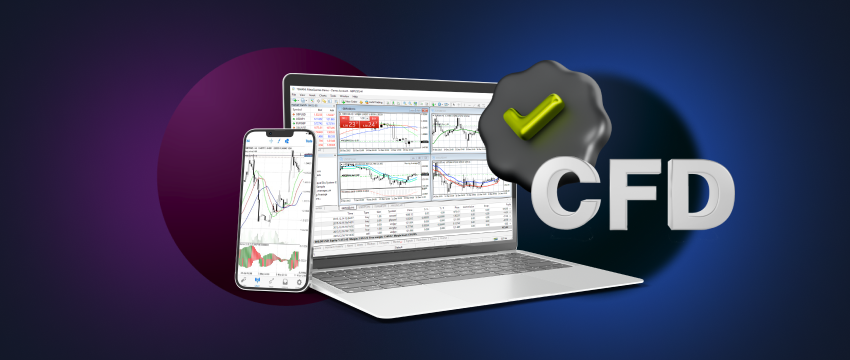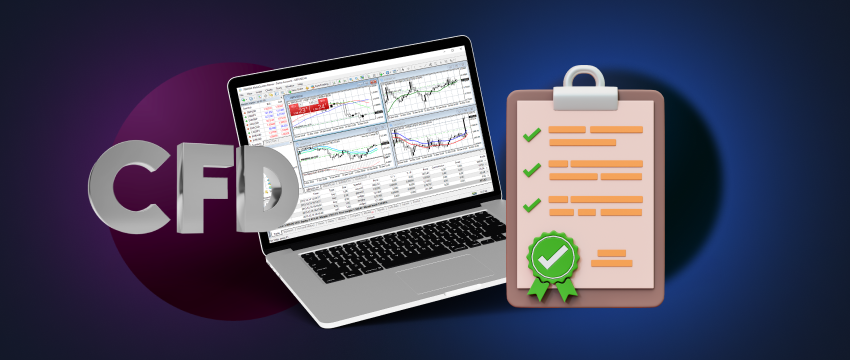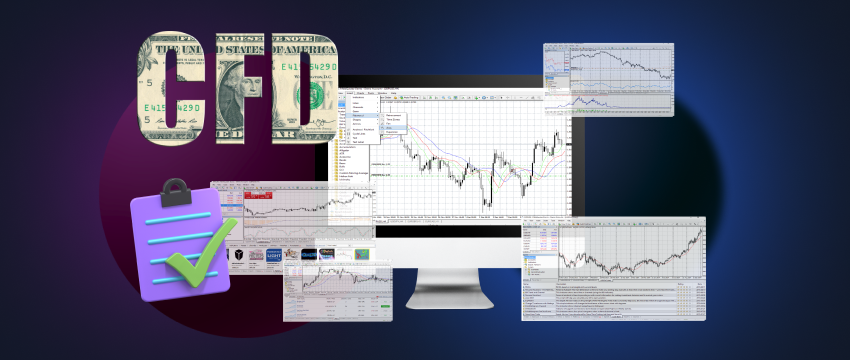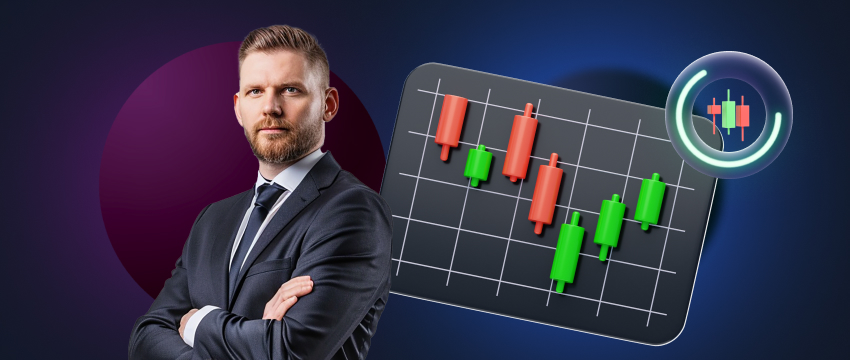CFD trading is an exciting activity that can prove profitable for traders, but not without its risks. The world of CFD trading comes with its own baggage of slang and insight knowledge. If you are planning to be in for the long run, maybe you need to master some of the terms.
Though when you start you may feel intimidated and question your knowledge, there is nothing that cannot be learned. In this article, we provide a useful list with all the terms you need to be aware of when you start trading CFDs.
Contract for Difference (CFD)
CFD stands for Contract for Difference and this is a financial product that allows the trader to buy a stake in the difference of the price of any chosen asset without owning the actual asset.
In other words, a CFD is a contract between the buyer and the seller on the delivery of the difference between the current market price. An asset at the time when the contract is opened, and at the point of closing.
This means that CFDs can be applied to trading of any market, be it the forex market, the stock market, or any other market. CFDs have become especially popular among traders due to the low margin requirements. The ability to speculate on bth rising and falling markets.
杠杆 and CFD
Leverage is one of the most efficient instruments of CFD trading which enables traders to manage a massive position using limited amounts of capital.
It is written with the format of a ratio like 1 to 50 or 1 to 100 to represent the maximum amount of the initial capital that can be brought.
For instance, 1:100 leverage enables the trader to open a position of $100.000, but they only need to deposit $1000 of their money. 杠杆, which means borrowing, helps increase profits but at the same time also increases the losses; thus, risk management plays a vital role.
Margin on CFD
Margin is therefore the amount of cash needed to fund an open and fully leveraged position. There are two types of margin: initial margin and maintenance margin.
Initial margin is the amount used to establish a position and the maintenance margin is the minimum amount required to keep the position in place.
If the account equity gets to the maintenance margin level, the trader is notified through a margin call, and they have to either top up their account or close orders to reduce exposure.

Spread
The spread is the difference between the bid rate, which is the rate at which you can sell a financial instrument, and the asking rate, at which you can purchase the same instrument.
It refers more to the price of trading a CFD and fluctuates depending on market conditions, the particular asset, and the chosen broker. A lower spread is preferred for an active trader, as it keeps costs down.
Pip
A pip stands for ‘percentage in point’, and it is the smallest price ‘ticked’ that can be measured in the Foreign Exchange (Forex) market.
It is usually quoted to at least four decimal places in most of the currencies but sometimes can be expressed up to five or even more decimal places for minor currencies.
For instance, if the seller was pricing the EUR/USD at 1.1000 and it moves to 1.1001, that is what we call a one pip change. A pip is an important tool when it comes to determining gains or losses.
Lot
A lot refers to the size of a transaction that is used in the forex market. There are three types of lots: standard, mini and micro. A standard lot measures 100,000 units of the base currency whereas a mini lot measures 10,000 units, with micro lot measuring 1,000 units.
This is done on the basis of the size of the lot thus translating into profit or losses for every movement in pips. New traders use mini and micro lots as it is easier to control their risks when they start CFD trading.
Stop order and trading CFD
A stop order is an order which attempts to avoid as much loss in a CFD trade by setting a point where the respective stock or currency pair may be sold. It’s an order given to the broker to sell a certain security once it reaches a specific price to cut losses and close the position.
For example, if the entry price was $50 with a stop price at $45, the trade will be closed when the $45 for the particular stock has been attained. This makes it easier for the traders to manage their risks.
Take profit with CFD
A take profit order is a direction given to a broker that a security should be sold at a certain price in order to secure profits on a position. For instance, when you are making a trade, you may trade at $50 and set your take-profit at $60, so the position will be closed at $60, that is, the profit gained will be locked. It lets traders define fixed profit levels and work out their trading plans and strategies much more efficiently.
波动性
This involves the amount of fluctuation in the price of a financial instrument in relation to time. High volatility means that the prices of a forex pair or commodity are much more volatile and unpredictable than those of assets that are relatively more stable.
Fluctuations in price represent a cyclical movement inherent in trading, since volatility directly defines the possible profit from a particular trade and the level of risk in it. That is why some traders perform well in conditions of high volatility while others tend to avoid them.
Liquidity
In other words, liquidity measures the ability of a given asset to be traded in the market easily, without massive changes in its price.
High liquidity tends to refer to assets that can be sold and bought easily since they are popular and tend to have small spreads.
On the other hand, high levels of illiquidity usually result in high spreads and even slippage. As a matter of fact, liquid markets involve the trading of major forex pairs and are normally preferred by most traders.

Bear Market
A bear market is when prices go down for a significant amount of time and where investors tend to be bearish—they believe prices will go down, and this tends to lead them to avoid buying assets, especially risky ones. During bear markets selling or short selling and other such mechanisms may be used to make money from the decline in prices.
Bull Market
A bull market is the opposite of a bull market where prices are moving up with investors and traders feeling optimistic.
对冲
Hedging is the act of protecting or minimising the risk on one stock or investment by locking into an opposite bet in another related stock or investment.
For instance, if you have a long position in a specific stock, you will hedge by short selling a similar stock. Hedging can therefore help in mitigating your portfolio against unfavourable market movements.
CFD trading platforms
Trading platforms are computer programs, with which traders can open and close trades and analyse price quotes. Some of the most used CFD trading platforms are MetaTrader 4 (MT4), MetaTrader 5 (MT5), and whatever in-house trading platforms your broker may provide. These platforms tend to offer various tools such as charting, indicators, and other automated trading features to assist you with your trading.
Equity
Equity is the aggregate amount of money that a trader has in his/her account, which comprises the deposited funds, and profits/losses from the existing trades.
It is used in the analysis of the trading account status and balance in order to establish available margins. Monitoring equity helps traders make decisions regarding the management of their CFD positions and the overall risk they can accept.
Drawdown
A drawdown represents the extreme low point of a 交易帳戶, which is quantified as a percentage of the account’s peak value. A large degree of fluctuation can suggest low levels of trading or high levels of risk which are unfavourable.
Being aware of this and ensuring you avoid drawdowns will protect your funds and allow you to trade CFD more effectively in the long term.
Slippage
This is a situation where an order you have placed ends up being filled at a different price than the intended price. This tends to happen during periods of gaps in the market or fast movements. Even though it occurs usually in very fast-changing markets, you should always go for a broker who is reliable and provides fast and consistent execution.

Rollover
Rollover, also referred to as swap, is the interest on the position held by the trader and charged or paid for the holding of the position till the next day. In forex trading, every single currency pair has its own interest rate differential and the rollover fee is based on this difference.
If you are in a long position and the currency you are long has a higher interest rate than the counter currency, then the rollover received would be positive. On the other hand, if the CFD interest rates are considerably low, your account may be charged with a negative rollover.
Risk-Reward Ratio
The risk-reward ratio is a statistical estimate of the profit that is expected in a particular trade as compared to the possible loss. This is calculated by dividing the profit by the possible loss. If you risk $100 to gain $300, then the risk-reward ratio will be 1:3. Risk/reward ratio is important to maintain a more balanced approach and avoid risking too much and gaining less.
Therefore, it is necessary to familiarise yourself with these key CFD trading definitions so you are ready to trade in the markets and also have meaningful discussions with your fellow traders.
However, educating yourself should not stop here and you should always feel motivated to learn more and sharpen your skills, as trading strategies are evolving and the markets are constantly moving.
免责声明: This material is for general informational and educational purposes only and should not be considered investment advice or an investment recommendation. T4Trade is not responsible for any data provided by third parties referenced or hyperlinked in this communication.




